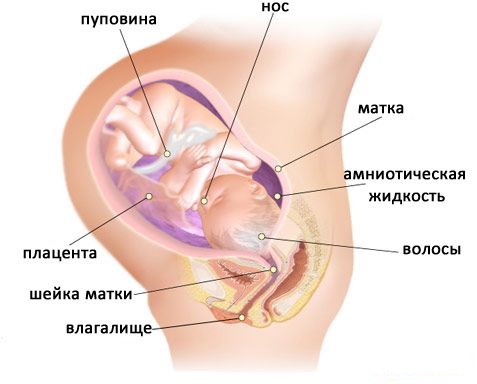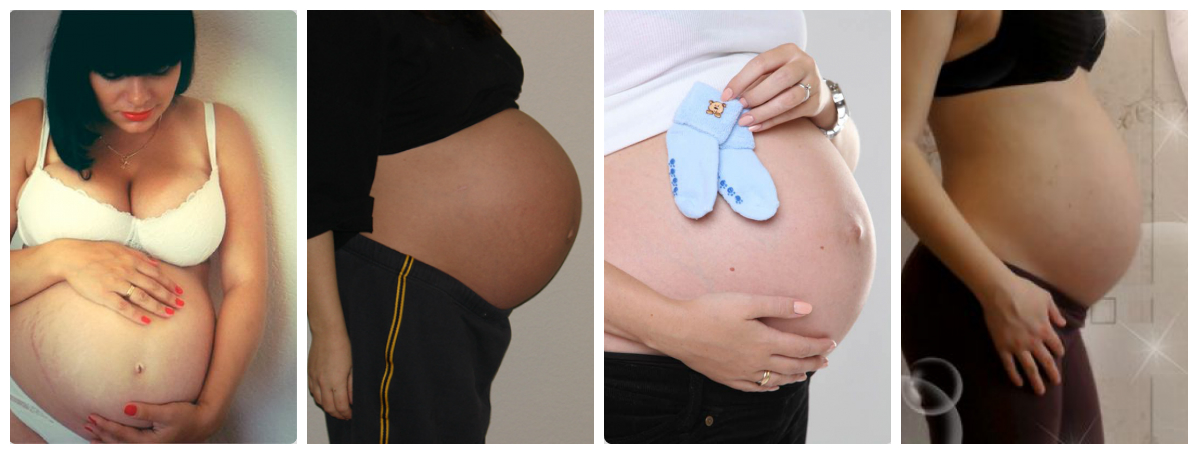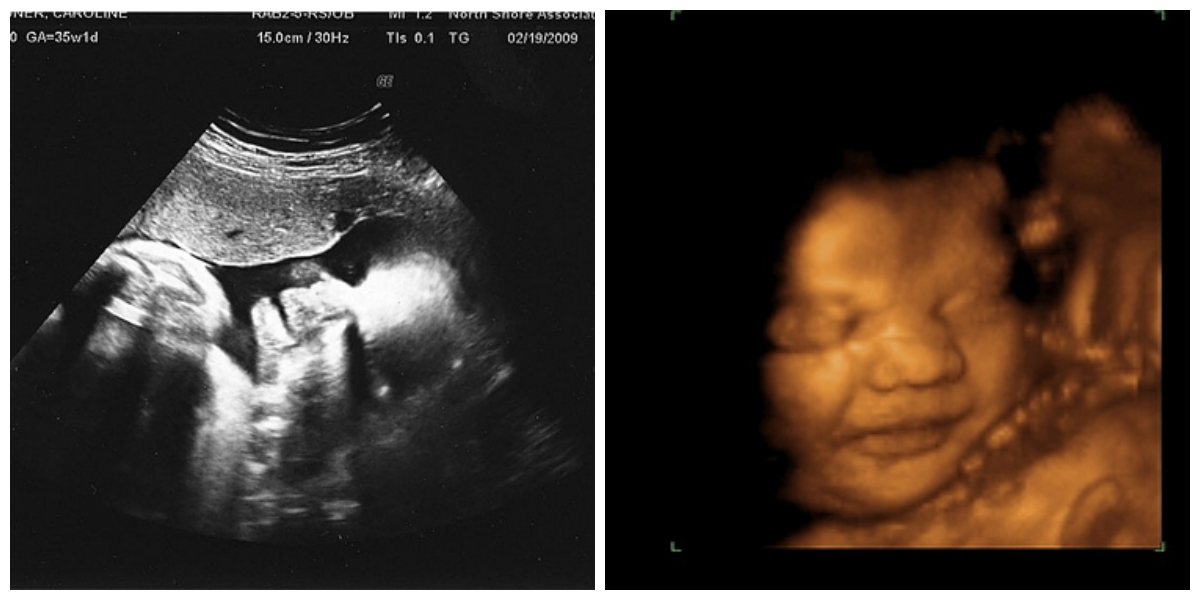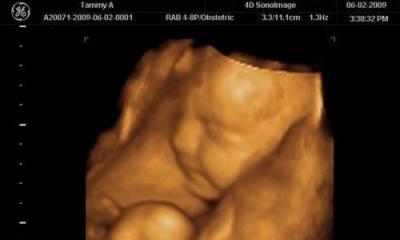The 35th week of pregnancy is the time when the child is already eager to see the white light, so the mother must be in full combat readiness. It is recommended during this period to always take an exchange card with you wherever you go. The penultimate month of pregnancy is coming to an end. All the organs of the baby are already formed. There's still a little left. Only a few weeks separate you from the long-awaited meeting. An even greater weight gain is noticeable, the stomach seems simply huge, and the body looks like a bun on legs. It has become more difficult to move around, but soon the tummy will begin to sink and breathing will be much easier. Perhaps this week is one of the most difficult weeks throughout pregnancy.
The fruit is well developed. His fully formed body is already functioning smoothly. Now the child accumulates fat and muscle mass, becoming strong. He gains about 200-230 grams per week.
Child's weight, height and size
The size of the fetus at the thirty-fifth week of pregnancy is about 42-47 centimeters. The diameter of the head is approximately 86 mm, the diameter of the chest is 90 mm, and the diameter of the abdomen is 93 mm. The parameters of the baby are individual, it all depends on heredity.
The uterus in the last weeks of pregnancy grows very rapidly. The weight of the child at the 35th week of pregnancy reaches 2.5-3 kg.
Mom's tummy is getting tighter, tumbling is now more difficult, because the movements of the crumbs resemble rolling. With interest, you can observe the tubercles on the abdomen when the baby sticks out its legs and arms.

What's new in its development
The development of the fetus at 35 weeks of gestation is still ongoing. The work of internal organs and the nervous system is debugged. In particular:
- This week, the adrenal glands are intensively developing, which are responsible for the formation of hormones that control the vital activity of the body;
- Some meconium has accumulated in the baby's intestines. This is the original feces that passes a few hours after birth. It is made up of skin cells and bile. Meconium does not usually pass into the amniotic fluid. However, if this happens (only in 10% of cases), then there is a potential danger of various complications;
- The facial features of the baby at this stage acquired their individuality, and the cheeks were rounded. The eye color is blue-gray now. Later it will change to the one that is genetically laid down;
- The skin is gradually smoothed, the lanugo fluff disappears, the body becomes pink. The baby is already very similar to a newborn. Hair continues to grow on the head;
- The fetus at 35 weeks of gestation settles comfortably in the tummy, preparing for the moment of birth. He drops head down, his shoulders and arms rounded. Such an inverted position for the child is absolutely comfortable. If the baby has not rolled over by the thirty-fifth week of pregnancy, you should not worry. During childbirth, experienced midwives will certainly take all the necessary measures to ensure that labor activity is successful.
Active perturbations and movements of the little one
The baby has grown a lot and is already pushing so hard that it causes you enough pain. The frequency of movements is normally about 15 times a day.
If the movements have stopped or become felt much less frequently, you should urgently contact your doctor in order to avoid the development of complications.
The condition of the expectant mother at 8 months
The thirty-fifth obstetric week of pregnancy is just that wonderful time when you are already on maternity leave and have a lot of free time for yourself. You can not waste time in vain and sign up for special courses for new mothers, if you have not already done so.
Unpleasant symptoms of pregnancy at this time
Symptoms at 35 weeks of gestation are especially worrisome for women. The hormones that are being released are just crazy!
- Suffer from mood swings. The psychological burden increases, most expectant mothers have fears of the upcoming birth. Anxiety about the health of the baby can cause insomnia. So no need to dwell on it! Thoughts about the future baby, how it will look, how you will admire it will help to distract;
- Stretch marks appear. Almost half of pregnant women begin to worry about stretch marks on the abdomen, thighs, and chest. Blame hereditary predisposition and characteristics of the body. It is quite difficult to get rid of them, so it is better to take care of the prevention of skin stretching in a timely manner;
- Worried about insomnia. Due to the large belly, it becomes difficult to sleep, it is difficult to find a comfortable position for normal sleep. Ventilate the room well and try not to overeat at night;
- Discharge with mucus. There may be a small amount of mucus of a homogeneous consistency in the secretions and this is normal. But the presence of scarlet discharge is a symptom of placental abruption, you must immediately call an ambulance. Also, seek medical help as soon as possible if the discharge has become profuse, watery, yellow-white in color. Most likely, this is amniotic fluid;
- puffiness. Often, edema appears due to excessive fluid intake by a pregnant woman, or their appearance may be associated with varicose veins due to an increased load on the vessels. Regular consultation with a gynecologist is necessary to rule out various diseases. You can not lie or sit for a long time, you should change your position as often as possible and warm up.
Characteristic sensations of the expectant mother
What happens at 35 weeks pregnant?
- Lost appetite. The growing belly presses on the chest and on the internal organs. It is important to stick to fractional nutrition, eat little, but more often. And getting used to proper nutrition, it will be easier for you to put your figure in order after childbirth. Now your weight gain is about 12 kilograms. The norm is a set of no more than 300 grams per week;
Do you want something interesting?
- Difficulty breathing. If there is a feeling of suffocation, you need to get on all fours, slowly inhale deeply, then exhale. Repeat until it gets easier. If the exercise does not help, call an ambulance!;
- Urination becomes more frequent. Frequent trips to the toilet are also unpleasant. An enlarged uterus presses on the bladder. You should try to drink less, especially after 6 pm. The norm of drinking liquid per day is one and a half liters;
- Concerned about constipation. Constipation can occur due to the pressure of the uterus on the intestines. It is recommended to reduce portions of food intake, add dried fruits to the diet (in particular, prunes);
- There may be pain in the hypochondrium. A simple exercise will help: take a deep breath, hold your breath, straighten your back, tilt to the left, stretch.
The size of the abdomen and the location of the baby
At this time, the bottom of the uterus is located 35 centimeters from the pubic joint and 15 centimeters from the navel. The navel looks protruding - this is absolutely natural and normal. Due to tension, the skin on the abdomen may begin to itch.
In cephalic presentation, the baby's head is at the entrance to the pelvis. After a week, the stomach will begin to fall.
If periodically the stomach pulls, and the uterus either tenses or relaxes, these are training contractions. But if the uterus is hard as a stone and does not relax, and also strongly pulls the stomach and back, then this most likely indicates the onset of labor.
It is urgent to go to the hospital to prolong the pregnancy until the due date.
However, sometimes it happens that doctors have to deliver at 35 weeks of pregnancy. A woman in labor should not panic! The child is now viable and fully matured. The likelihood that everything will go well, the baby will be born without any deviations and even be able to breathe on its own, is already very high. But the birth of twins at such a time is completely the norm.
The tummies look like this at 35 weeks of gestation:

Important medical examinations at 35 weeks
Consultations with a gynecologist for a period of 35 weeks of pregnancy are now scheduled once a week, more often if necessary. This week you will have regular medical examinations. Some retests are being done. Weight, pressure on both hands are measured, the height of the fundus of the uterus is measured, the baby's heartbeat is heard. Ultrasound is also ordered.
What tests need to be done
As usual, before each appointment with a gynecologist, it is necessary to pass a general urine test. And also at this time, repeated tests for HIV infection, syphilis, a biochemical blood test and a smear for various infectious diseases are given.
If the results of the tests are not very good, then the doctors can take you under their control by putting you in the pathology department.
If all tests are normal, then continue to visit the gynecologist weekly, waiting for the onset of labor.
Ultrasound results
Ultrasound at the thirty-fifth week of pregnancy is performed in order to evaluate the following parameters:
- the state of the placenta (for a period of 35 weeks, the placenta should have a second stage of maturity);
- height and weight of the fetus;
- the position of the child (pelvic or head);
- motor activity of the baby;
- fetal heartbeat;
- the condition of the umbilical cord and the presence of entanglement;
- the amount of amniotic fluid, as well as their quality (transparency).
Ultrasound allows you to make sure whether the baby is ready for birth, whether he has no pathologies and congenital malformations.

Possible complications at this stage of pregnancy
Most often, the causes of all fetal pathologies are your illnesses and bad habits: kidney disease, anemia, severe weight gain, smoking during pregnancy. Possible complications include:
- Placenta previa or abruption - accompanied by considerable blood loss during childbirth, it is important to identify this pathology in advance;
- Preeclampsia (late toxicosis) - accompanied by headaches, nausea and high blood pressure;
- Low water or polyhydramnios.
If you experience any painful sensations that are unbearable to endure, you should immediately consult a doctor. In case of complications, the pregnant woman is usually placed for preservation in the maternity hospital.
- It is recommended to walk daily in the fresh air for several hours. This is useful for both you and the baby, but the main thing is not to overdo it! Don't go shopping, don't carry heavy things, and don't let yourself get very tired. Walking should be just a pleasure!;
- The gained kilograms put pressure on the internal organs, so try to change the position of the body as often as possible so that the limbs do not become numb. You can not sit for a long time, every half hour you need to get up and do a warm-up. It is important to remember that the cross-legged position during pregnancy is taboo, because it is fraught with circulatory disorders;
- At this stage, it is worth taking care of choosing a maternity hospital. Start with a consultation with the gynecologist who is managing your pregnancy. He can offer a specialized maternity hospital for special indications. Then read reviews on the Internet about each institution in your city, ask for the opinion of friends who have recently given birth. It is important to learn about the conditions for women in labor in each maternity hospital in advance. It is probably better to choose from maternity hospitals that are not far from your home, so that in an emergency you can quickly get there. In addition, it is advisable to give preference to the maternity hospital, where resuscitation for children is provided and where a specialist in newborns is always on duty;
- Prepare all the necessary things and documents for the hospital. This also needs to be taken care of in advance. What if the baby wants to be born a little earlier than the scheduled time? It is also better to prepare immediately and things for discharge. You can already buy a nursing bra and special clothes now;
- Discuss with your husband and come up with a name for the baby. Do you already know his gender?
- It is also worth thinking in advance about who you would like to see next to you during childbirth as support. Modern families give birth together. Many mothers argue that joint childbirth with her husband helps to strengthen intra-family relations, increasing the level of trust between spouses. However, if the husband, for one reason or another, refuses to be present next to you in the delivery room, you should not force him to do this. Alternatively, you can take your mother or a close friend with you. There is also a special service - support during childbirth. And you can not take anyone at all. Experienced obstetricians in their field will tell and show everything. The main thing is not to be afraid and believe that the birth will pass without complications for both the baby and you.
This material is for informational purposes only, before using the information provided, you must be sure to consult with a specialist.








